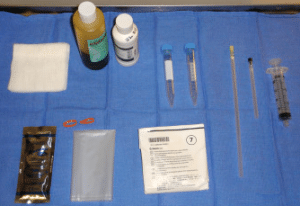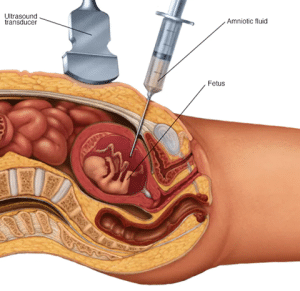Background
Amniocentesis is a diagnostic medical procedure. It was founded in the mid-20th century. It is developed to obtain information about the chromosomal health and genetic health of a developing fetus during pregnancy. The procedure includes the extraction of a little amount of the amniotic fluid from amniotic sac of the developing fetus. The amniotic fluid contains cells which are shed by a developing fetus. The analysis of amniotic cells will provide important information about chromosomal abnormalities, genetic disorders, and certain birth defects.
Between the 15th and 20th week of pregnancy, Amniocentesis is performed. It is suggested for women with a high risk of having a child with a genetic condition. With advancements in technology and medical understanding, amniocentesis has been made safer and more accurate over the years. This can make it a valuable procedure in prenatal care to assess the health and well-being of a developing fetus.
Indications
Contraindications
Outcomes
Periprocedural Evaluation
Equipment

patient preparation and monitoring
Monitoring During Amniocentesis
TECHNIQUE
Step: 1 – Approach:
Patient Positioning: The patient usually lies on her back with an exposed abdomen.
Ultrasound Guidance: An ultrasound is used to see the fetus, amniotic fluid pockets, and assist in the procedure.
Step: 2 – Skin Preparation:
Cleaning: The skin of the abdomen is cleaned with an antiseptic solution to lower the risk of infection.
Step: 3 – Local Anesthesia:
Administration: Local anesthesia like lidocaine is administered into the skin and underlying tissue at the needle insertion site.
Step: 4 – Needle Insertion:
Ultrasound Guidance: A thin, sterilized needle is inserted into the abdominal wall and into the amniotic sac by using a real-time ultrasound.
Avoidance of Fetal Injury: Take care to avoid the contact with the placenta, fetus, and umbilical cord during the insertion of needle.
Step: 5 – Amniotic Fluid Collection:
Withdrawal: A syringe is attached to the needle and a small amount of amniotic fluid is withdrawn. Usually, 20 ml of fluid is taken out.
Collection in Sterile Tubes: The collected sample is transferred into a sterile collection tube for analysis.
Step: 6 – Removal of Needle:
Careful Withdrawal: The needle is carefully removed, and pressure is given on the insertion site to reduce the risk of bleeding.

Genetics and Chromosomal Analysis
Fluorescence In Situ Hybridization (FISH)
Fetal Lung Maturity Assessment
Premature Rupture of Membranes (PPROM)
Complications
Medication Summary
Immune Globulins
Rho(D) immune globulin (RhoGAM) is not directly administered during amniocentesis. It is suggested in specific conditions to prevent Rh isoimmunization. Rh isoimmunization develops when Rh-negative mother is exposed to Rh-positive fetal blood. This can lead to development of antibodies which can have risk in subsequent pregnancy.
Rh-negative Pregnant Women: Rh-negative women can get Rho(D) immune globulin during pregnancy. She can also get it after procedures like amniocentesis to prevent the development of Rh antibodies.
Preventing Rh Isoimmunization:
Amniocentesis has a risk of combining the maternal and fetal blood and if the fetal blood has Rh-positive and mother has Rh-negative, then there is a risk of sensitization.
RhoGAM is administered to Rh-negative pregnant women within 72 hours after the amniocentesis or other procedure which may expose the fetal blood o mother blood to reduce the risk of Rh isoimmunization.
RhoGAM prevents the development of Rh antibodies in Rh-negative mothers, reduce the risk of hemolytic disease of newborn (HDN) in subsequent pregnancy. It is preventive measurement in the situations where there is a risk of combination of maternal and fetal blood like chorionic villus sampling (CVS), amniocentesis, or any other procedure which have a risk of Rh sensitization.
Medication
Medication

Amniocentesis is a diagnostic medical procedure. It was founded in the mid-20th century. It is developed to obtain information about the chromosomal health and genetic health of a developing fetus during pregnancy. The procedure includes the extraction of a little amount of the amniotic fluid from amniotic sac of the developing fetus. The amniotic fluid contains cells which are shed by a developing fetus. The analysis of amniotic cells will provide important information about chromosomal abnormalities, genetic disorders, and certain birth defects.
Between the 15th and 20th week of pregnancy, Amniocentesis is performed. It is suggested for women with a high risk of having a child with a genetic condition. With advancements in technology and medical understanding, amniocentesis has been made safer and more accurate over the years. This can make it a valuable procedure in prenatal care to assess the health and well-being of a developing fetus.

Step: 1 – Approach:
Patient Positioning: The patient usually lies on her back with an exposed abdomen.
Ultrasound Guidance: An ultrasound is used to see the fetus, amniotic fluid pockets, and assist in the procedure.
Step: 2 – Skin Preparation:
Cleaning: The skin of the abdomen is cleaned with an antiseptic solution to lower the risk of infection.
Step: 3 – Local Anesthesia:
Administration: Local anesthesia like lidocaine is administered into the skin and underlying tissue at the needle insertion site.
Step: 4 – Needle Insertion:
Ultrasound Guidance: A thin, sterilized needle is inserted into the abdominal wall and into the amniotic sac by using a real-time ultrasound.
Avoidance of Fetal Injury: Take care to avoid the contact with the placenta, fetus, and umbilical cord during the insertion of needle.
Step: 5 – Amniotic Fluid Collection:
Withdrawal: A syringe is attached to the needle and a small amount of amniotic fluid is withdrawn. Usually, 20 ml of fluid is taken out.
Collection in Sterile Tubes: The collected sample is transferred into a sterile collection tube for analysis.
Step: 6 – Removal of Needle:
Careful Withdrawal: The needle is carefully removed, and pressure is given on the insertion site to reduce the risk of bleeding.

Rho(D) immune globulin (RhoGAM) is not directly administered during amniocentesis. It is suggested in specific conditions to prevent Rh isoimmunization. Rh isoimmunization develops when Rh-negative mother is exposed to Rh-positive fetal blood. This can lead to development of antibodies which can have risk in subsequent pregnancy.
Rh-negative Pregnant Women: Rh-negative women can get Rho(D) immune globulin during pregnancy. She can also get it after procedures like amniocentesis to prevent the development of Rh antibodies.
Preventing Rh Isoimmunization:
Amniocentesis has a risk of combining the maternal and fetal blood and if the fetal blood has Rh-positive and mother has Rh-negative, then there is a risk of sensitization.
RhoGAM is administered to Rh-negative pregnant women within 72 hours after the amniocentesis or other procedure which may expose the fetal blood o mother blood to reduce the risk of Rh isoimmunization.
RhoGAM prevents the development of Rh antibodies in Rh-negative mothers, reduce the risk of hemolytic disease of newborn (HDN) in subsequent pregnancy. It is preventive measurement in the situations where there is a risk of combination of maternal and fetal blood like chorionic villus sampling (CVS), amniocentesis, or any other procedure which have a risk of Rh sensitization.

Both our subscription plans include Free CME/CPD AMA PRA Category 1 credits.

On course completion, you will receive a full-sized presentation quality digital certificate.
A dynamic medical simulation platform designed to train healthcare professionals and students to effectively run code situations through an immersive hands-on experience in a live, interactive 3D environment.

When you have your licenses, certificates and CMEs in one place, it's easier to track your career growth. You can easily share these with hospitals as well, using your medtigo app.



